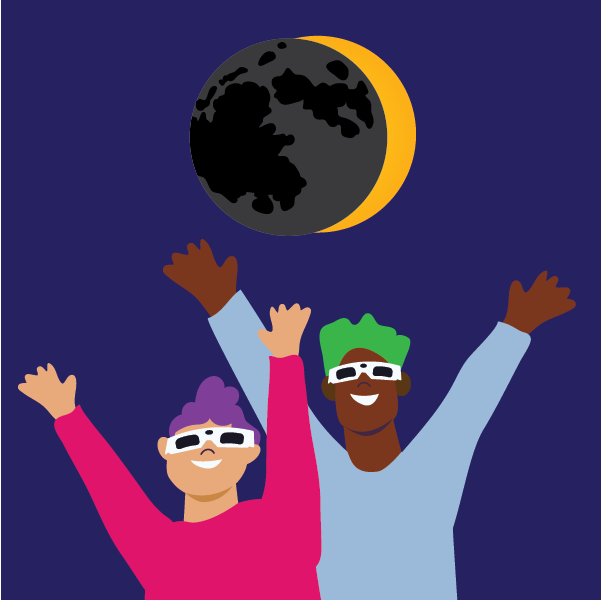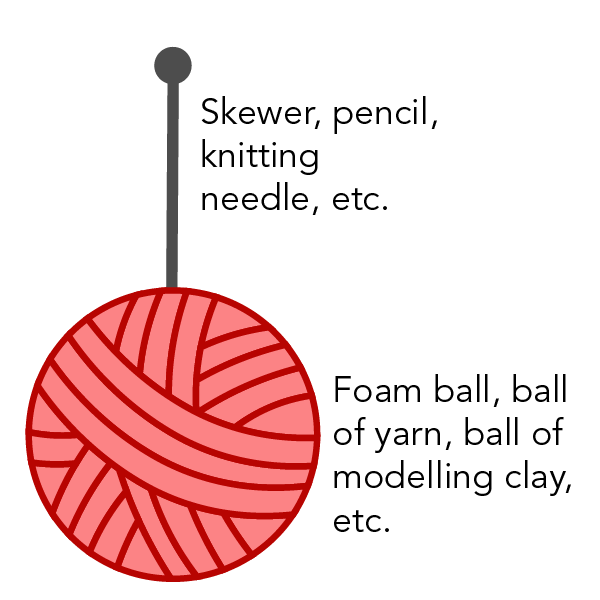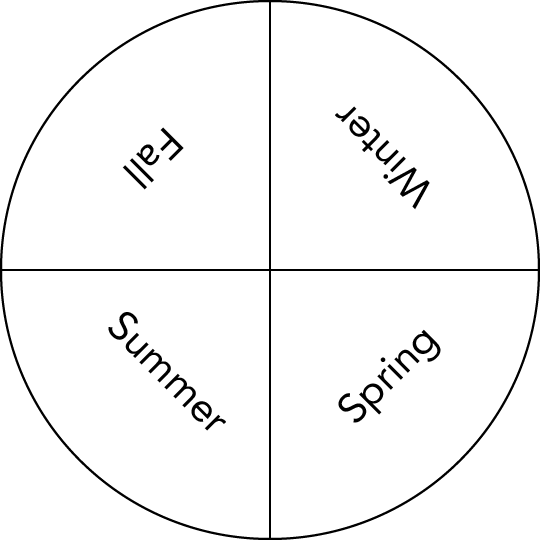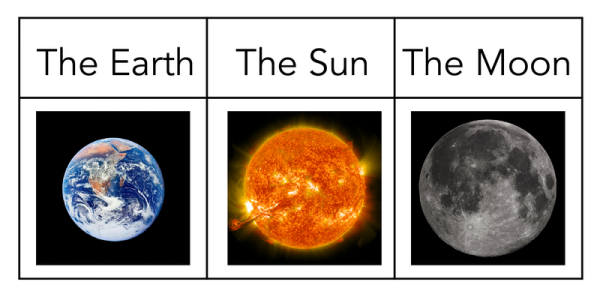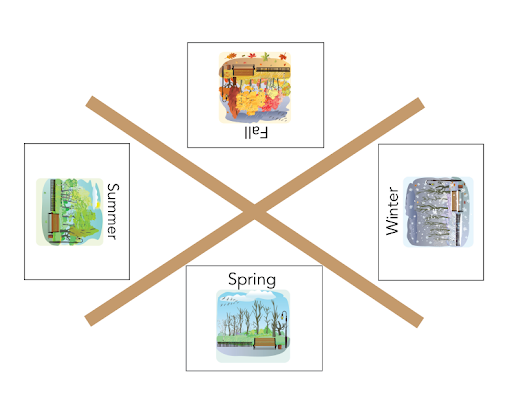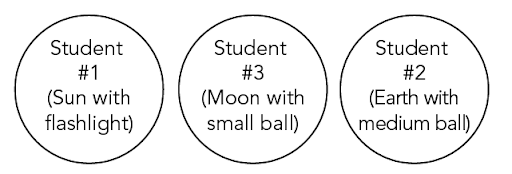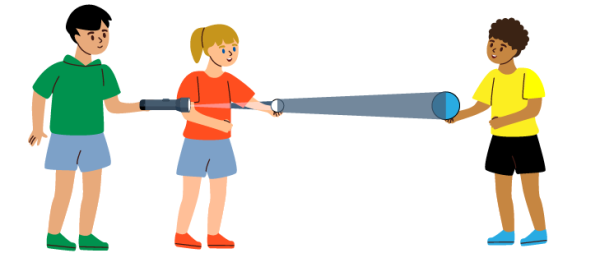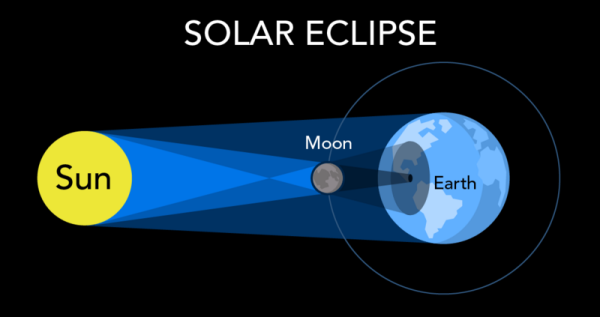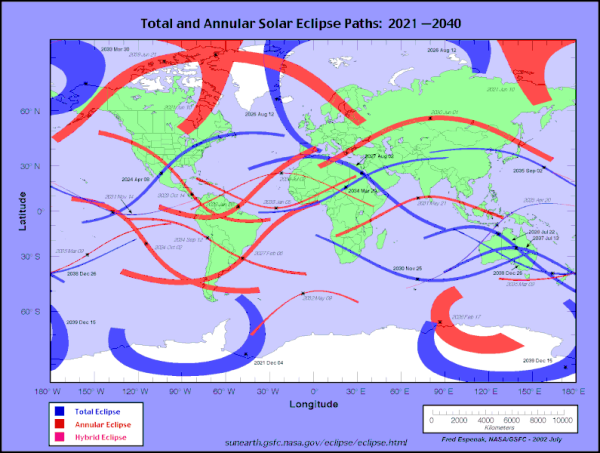Students will:
- Develop a basic understanding of the patterns of movement of the Earth, Moon and Sun
- Develop a basic understanding of why solar eclipses occur
Learning Goals
Students will:
- Develop a basic understanding of the patterns of movement of the Earth, Moon and Sun
- Develop a basic understanding of why solar eclipses occur
Students can:
- Actively roleplay the movement of the Earth around the Sun and the Moon around the Earth
- Describe and predict patterns related to the Earth, Moon and Sun (i.e., day/night, seasons)
- Explain why a solar eclipse occurs
Success Criteria
Students can:
- Actively roleplay the movement of the Earth around the Sun and the Moon around the Earth
- Describe and predict patterns related to the Earth, Moon and Sun (i.e., day/night, seasons)
- Explain why a solar eclipse occurs
This icon indicates potential assessment opportunities.
Observations
- Observe and record anecdotally students’ responses to questions asked about the Earth, the Sun and the Moon (Minds-on).
- Observe and record anecdotally students’ participation during the roleplay activities (Action).
Conversations
- Have conversations with students about the patterns of day/night and seasons (Action, Consolidation)
- Have students explain why a solar eclipse occurs (Consolidation)
Evidence of Student Learning
This icon indicates potential assessment opportunities.
Observations
- Observe and record anecdotally students’ responses to questions asked about the Earth, the Sun and the Moon (Minds-on).
- Observe and record anecdotally students’ participation during the roleplay activities (Action).
Conversations
- Have conversations with students about the patterns of day/night and seasons (Action, Consolidation)
- Have students explain why a solar eclipse occurs (Consolidation)
Students will:
- Develop a basic understanding of the patterns of movement of the Earth, Moon and Sun
- Develop a basic understanding of why solar eclipses occur
Learning Goals
Students will:
- Develop a basic understanding of the patterns of movement of the Earth, Moon and Sun
- Develop a basic understanding of why solar eclipses occur
Students can:
- Actively roleplay the movement of the Earth around the Sun and the Moon around the Earth
- Describe and predict patterns related to the Earth, Moon and Sun (i.e., day/night, seasons)
- Explain why a solar eclipse occurs
Success Criteria
Students can:
- Actively roleplay the movement of the Earth around the Sun and the Moon around the Earth
- Describe and predict patterns related to the Earth, Moon and Sun (i.e., day/night, seasons)
- Explain why a solar eclipse occurs
This icon indicates potential assessment opportunities.
Observations
- Observe and record anecdotally students’ responses to questions asked about the Earth, the Sun and the Moon (Minds-on).
- Observe and record anecdotally students’ participation during the roleplay activities (Action).
Conversations
- Have conversations with students about the patterns of day/night and seasons (Action, Consolidation)
- Have students explain why a solar eclipse occurs (Consolidation)
Evidence of Student Learning
This icon indicates potential assessment opportunities.
Observations
- Observe and record anecdotally students’ responses to questions asked about the Earth, the Sun and the Moon (Minds-on).
- Observe and record anecdotally students’ participation during the roleplay activities (Action).
Conversations
- Have conversations with students about the patterns of day/night and seasons (Action, Consolidation)
- Have students explain why a solar eclipse occurs (Consolidation)
Materials and Preparation
| Material/Technology/Setting | Quantity |
|---|---|
If in the classroom
If going outdoors
If using the gym
* Can be substituted with images you already have |
For teacher use |
|
1 or more |
Materials
| Material/Technology/Setting | Quantity |
|---|---|
If in the classroom
If going outdoors
If using the gym
* Can be substituted with images you already have |
For teacher use |
|
1 or more |
- Create an Earth, Sun, Moon chart similar to the one below on paper, a whiteboard, etc.
The Earth The Sun The Moon
- Poke the object you are using to represent the Earth’s axis (bamboo skewer, etc.) through the centre of the ball (foam, yarn, etc.).
Image - Text Version
Shown is a colour diagram of a knitting needle poked into a ball of yarn. The needle is long, thin, and dark grey, with a small sphere at the top. It is poked into the top centre of a spherical ball of pink yarn. Near the needle is the label “Skewer, pencil, knitting needle, etc.” Near the ball of yarn is the label “Foam ball, ball of yarn, ball of modelling clay, etc.”
- Print out the images or gather your own.
- Students will need a large open area for the activities. Plan accordingly. For optimal results, this should be somewhere you can turn off the lights.
- If going outside, draw a large circle on the pavement. Draw lines dividing the circle into quarters and write the name a season in each quarter.
Image - Text Version
Shown is a black and white diagram of a circle divided into four quarters, labelled with seasons. The circle is sliced like a pizza, into four equal pieces. The top left quarter is labelled “Fall.” The top right is labelled “Winter.” The lower left is labelled “Summer.” The lower right is labelled “Spring.” The labels are diagonal in each quarter, facing the outside edge of the circle.
Preparation
- Create an Earth, Sun, Moon chart similar to the one below on paper, a whiteboard, etc.
The Earth The Sun The Moon
- Poke the object you are using to represent the Earth’s axis (bamboo skewer, etc.) through the centre of the ball (foam, yarn, etc.).
Image - Text Version
Shown is a colour diagram of a knitting needle poked into a ball of yarn. The needle is long, thin, and dark grey, with a small sphere at the top. It is poked into the top centre of a spherical ball of pink yarn. Near the needle is the label “Skewer, pencil, knitting needle, etc.” Near the ball of yarn is the label “Foam ball, ball of yarn, ball of modelling clay, etc.”
- Print out the images or gather your own.
- Students will need a large open area for the activities. Plan accordingly. For optimal results, this should be somewhere you can turn off the lights.
- If going outside, draw a large circle on the pavement. Draw lines dividing the circle into quarters and write the name a season in each quarter.
Image - Text Version
Shown is a black and white diagram of a circle divided into four quarters, labelled with seasons. The circle is sliced like a pizza, into four equal pieces. The top left quarter is labelled “Fall.” The top right is labelled “Winter.” The lower left is labelled “Summer.” The lower right is labelled “Spring.” The labels are diagonal in each quarter, facing the outside edge of the circle.
- Some familiarity with the Earth, Earth’s moon and the Sun.
- Students could do the Let’s Talk Science lesson: Why is there Day and Night? and/or Cycle of Day and Night before this lesson.
Student Prior Knowledge and Skills
- Some familiarity with the Earth, Earth’s moon and the Sun.
- Students could do the Let’s Talk Science lesson: Why is there Day and Night? and/or Cycle of Day and Night before this lesson.
| Material/Technology/Setting | Quantity |
|---|---|
If in the classroom
If going outdoors
If using the gym
* Can be substituted with images you already have |
For teacher use |
|
1 or more |
Materials
| Material/Technology/Setting | Quantity |
|---|---|
If in the classroom
If going outdoors
If using the gym
* Can be substituted with images you already have |
For teacher use |
|
1 or more |
- Create an Earth, Sun, Moon chart similar to the one below on paper, a whiteboard, etc.
The Earth The Sun The Moon
- Poke the object you are using to represent the Earth’s axis (bamboo skewer, etc.) through the centre of the ball (foam, yarn, etc.).
Image - Text Version
Shown is a colour diagram of a knitting needle poked into a ball of yarn. The needle is long, thin, and dark grey, with a small sphere at the top. It is poked into the top centre of a spherical ball of pink yarn. Near the needle is the label “Skewer, pencil, knitting needle, etc.” Near the ball of yarn is the label “Foam ball, ball of yarn, ball of modelling clay, etc.”
- Print out the images or gather your own.
- Students will need a large open area for the activities. Plan accordingly. For optimal results, this should be somewhere you can turn off the lights.
- If going outside, draw a large circle on the pavement. Draw lines dividing the circle into quarters and write the name a season in each quarter.
Image - Text Version
Shown is a black and white diagram of a circle divided into four quarters, labelled with seasons. The circle is sliced like a pizza, into four equal pieces. The top left quarter is labelled “Fall.” The top right is labelled “Winter.” The lower left is labelled “Summer.” The lower right is labelled “Spring.” The labels are diagonal in each quarter, facing the outside edge of the circle.
Preparation
- Create an Earth, Sun, Moon chart similar to the one below on paper, a whiteboard, etc.
The Earth The Sun The Moon
- Poke the object you are using to represent the Earth’s axis (bamboo skewer, etc.) through the centre of the ball (foam, yarn, etc.).
Image - Text Version
Shown is a colour diagram of a knitting needle poked into a ball of yarn. The needle is long, thin, and dark grey, with a small sphere at the top. It is poked into the top centre of a spherical ball of pink yarn. Near the needle is the label “Skewer, pencil, knitting needle, etc.” Near the ball of yarn is the label “Foam ball, ball of yarn, ball of modelling clay, etc.”
- Print out the images or gather your own.
- Students will need a large open area for the activities. Plan accordingly. For optimal results, this should be somewhere you can turn off the lights.
- If going outside, draw a large circle on the pavement. Draw lines dividing the circle into quarters and write the name a season in each quarter.
Image - Text Version
Shown is a black and white diagram of a circle divided into four quarters, labelled with seasons. The circle is sliced like a pizza, into four equal pieces. The top left quarter is labelled “Fall.” The top right is labelled “Winter.” The lower left is labelled “Summer.” The lower right is labelled “Spring.” The labels are diagonal in each quarter, facing the outside edge of the circle.
- Some familiarity with the Earth, Earth’s moon and the Sun.
- Students could do the Let’s Talk Science lesson: Why is there Day and Night? and/or Cycle of Day and Night before this lesson.
Student Prior Knowledge and Skills
- Some familiarity with the Earth, Earth’s moon and the Sun.
- Students could do the Let’s Talk Science lesson: Why is there Day and Night? and/or Cycle of Day and Night before this lesson.
Teaching and Learning Activities
This icon indicates potential assessment opportunities.
Minds-On: What do we know about the Earth, Moon and Sun? [20 min.]
| Instructions | Teaching Tips |
|---|---|
|
Begin with a classroom discussion to find out what students already know about the Earth, the Sun and the Moon. Discuss each one at a time using discussion prompts such as the ones on the right. As you do so, begin to fill in the chart with words and images. Begin with the Earth, then go on to the Sun and Moon. As each is discussed, add the corresponding image to the chart. Image - Text VersionShown are labelled colour photographs of the Earth, Sun and Moon in a table. The table has three columns and two rows. The top row contains the labels, and the bottom row has photographs. The left photograph is labelled “The Earth.” It shows a blue and white sphere against black space. The centre photograph is labelled “The Sun,” and shows an orange, glowing sphere against black space. The right photograph is titled “The Moon, “ and shows a grey, mottled sphere against black space. Explain to the students that next they will pretend that they are the Earth, the Moon and the Sun. |
DiscussionsDiscussion prompts can include:
IdeaSupport younger students by showing the image and then following up with questions. |
Action: Sun-Earth-Moon Active Roleplay [30 min.]
| Instructions | Teaching Tips |
|---|---|
1. Day and Night RoleplayAsk the question: Does the Earth move? How do you know? Young students are likely to respond “no” because to them, the Earth does not look or feel like it is moving. Explain to students that the Earth is moving and by living on it, we are moving too! Have students stand and form a circle. It is best for younger children if they can stand on a circle. This may be:
Stand in the centre of the circle and explain that the students are to imagine that you are the Sun and that each of them is the Earth. Encourage them to use the bodies to represent Earth (e.g., hold their hands or arms to form a circle). Hold the large ball in your hands to represent the Sun. Explain that the Sun is in the centre of our Solar System and that it shines outwards in all directions like a bright and hot glowing ball. Leave the ball on the floor in the centre of the circle, then join the circle yourself. Explain that we see day and night on Earth because the Earth is turning on what is called its “axis”. The axis is an imaginary line that goes from the top to the bottom of the Earth. Show students the ball on the axis and have them imagine that the ball is the Earth and the skewer is the Earth’s axis. Turn the skewer so that they can see the ball turn. It’s a bit like spinning a top. Have students imagine that they have an axis that goes from their head to their feet. At their spots in the circle, have the students slowly turn on their axis (turn in place) until they once again face the centre of the circle. Tell students that when the Earth does one full turn on its axis, we call it a day. Now, have students think about the Sun. If you are the Earth and you are facing the Sun, what time of day do you think it is? Help them to understand that this is midday, when the Sun is highest in the sky. When your back is to the Sun, what time of day do you think it is? At this point, they may understand that it is night. Have students slowly turn again but stop them at a quarter of the way around and identify the time of day (sunset), repeat at the halfway mark (night), and the three quarters mark (sunrise). Call out the times of day in order and have students move to those positions. Identify to students that how they see the Sun throughout the day forms a repeating pattern. Ask students what comes next in the pattern (e.g., Sunrise, midday, ____) |
SafetyEnsure that students have enough room to move around without bumping into others. Any students who experience dizziness should not do the turning in circles part of the activity.
LanguageYou may wish to introduce or use the word “cycle” to describe this type of repeating pattern. |
2. Seasons RoleplayFollow up the day-night roleplay with a similar activity for the seasons. Tell students that the Earth also moves around the Sun. It does this much more slowly. Ask the question: How long do you think it takes the Earth to go once around the Sun? Answers will vary, but some children may know that it takes a year, or 365 days, for the Earth to orbit the Sun. Tell students that we call the time it takes for the Earth to go once around the Sun is called a year. A year is 365 days. While still in the circle, have students walk around the circle. As they do so, call out the months. Once they get the idea, they can call out the months along with you. Tell students that as the Earth goes around the Sun, that is why we have seasons. If you are in the classroom or the gym, place the two metre sticks or tape on the floor in the centre of the circle to form a cross. Place the four seasons images into the quadrants it forms. Image - Text VersionShown is a colour illustration of a large X, with printed illustrations in between the lines. The illustration is shown as if looking down at the ground. The X divides the space into four sections. Each section contains one piece of paper with a labelled illustration of a season. These are facing the outside edges of the illustration. The top centre section has an illustration labelled “Fall.” It shows trees with red and orange leaves falling to the ground. The right section has an illustration labelled “Winter.” It shows the same trees with no leaves, and snow falling. The bottom centre has an illustration labelled “Spring.” It shows the trees are still bare, but with green grass and birds in the bright blue sky above. The left section has an illustration labelled “Summer.” It shows the same trees, full with green leaves. The grass is also green and the sun is bright yellow in the sky. Have students name the four seasons. Designate one student to be the leader. Give this student the medium-sized ball. This ball represents the Earth. Have the children walk around the circle again. This time the leader calls out each season as they walk by. Repeat with several students. Ask students what comes next in the pattern (or cycle) (e.g., Spring, Summer, ____, _____) |
IdeaIt helps to watch one student as they move around the circle, calling out the months as they get to points, like the hands of a clock. IdeaHave students say this poem as they walk from season to season: Winter, spring, summer, fall Which do you like best of all? |
3. Earth-Moon-Sun RoleplayAsk the question: Does the Moon move? How do you know? Some students may have seen the Moon move during the night. Explain to students that just like the Earth goes around the Sun, the Moon also goes around the Earth. Show the students that this time the small ball will represent the moon. Explain that the time it takes for the Moon to go around the earth is around 1 month. Have the students sit or stand in a circle. Choose three students to come to the centre of the circle.
Repeat with other students in groups of three. |
SafetyEnsure that students have enough room to move around without bumping into others. Any students who experience dizziness should not do the turning in circles part of the activity. IdeaIf you have extra adults available, demonstrate first with the adults. Images and VideosYou can see Kindergarten children doing a similar activity in this video. You may want to record students doing the activity using Flip. |
4. Solar Eclipse demonstrationWith the final group of students from the previous activity, have the students stop in place so that the students are in a line like this. Give student #1 a flashlight. Image - Text VersionShown is a black and white diagram of three labelled circles in a horizontal row. The text inside the left circle reads, “Student #1 (Sun with flashlight.)” The text in the centre circle reads, “Student #3 (Moon with small ball.)” The text in the right circle reads, “Student #2 (Earth with medium ball.” Explain that once every few years, the Sun, the Moon and the Earth are perfectly in a line. Sometimes when this happens, the Moon can block out the light from the Sun. When this happens, we call it a solar eclipse. Have students say this with you. When the Moon blocks all of the light, we call it a total solar eclipse. This may not seem possible since the Sun is so much larger than the Moon, but it works because of the distance between them. Have student #1 and Student #3 stand at such a distance that when Student #2 looks towards the flashlight, the light is blocked by the small ball. Image - Text VersionShown is a colour illustration of three students with different objects, standing in a row. The student on the left is pointing a flashlight towards a small ball held by the student in the centre. The left half of the ball is white, illuminated by the flashlight beam. The right half is dark grey, in shadow. This shadow stretches from the first ball, to a larger ball, held by the student on the right. The left half of this ball is dark grey, in shadow. The right half is bright blue. Have Student #1 and #3 stand in place while the rest of the students come to where Student #2 is standing to see the effect. |
IdeaIf you have extra flashlights and adults, you could run multiple demonstrations at once. IdeaYou can also demonstrate the process by holding up your thumb and using it to block much larger objects in the distance! IdeaInstead of using a flashlight, use the light from an overhead projector as a light source and place the medium ball at the screen where the light is projected. Move the small ball in such a way as to create a shadow on the medium ball. |
Consolidation: Solar Eclipse Safety [15 min.]
| Instructions | Teaching Tips |
|---|---|
|
Recap key ideas from the lesson with the students using questions such as the ones on the right. You may want to have sticky notes with you for recording student responses. |
Discussions
|
| Before the day of the eclipse, read to students the e-book Here comes a total eclipse (e-book) and review how to safely observe the event using the Solar Eclipse Safety Poster [PDF]. |
IdeaPost the poster in a visible location. You may also want to send copies home with students. Images and VideosFor students who are blind or have low vision, describe the images in addition to reading the text in the e-book. |
Background Information for Teachers
Solar Eclipses
What is a solar eclipse?
During a solar eclipse, the Moon casts a shadow on the Earth. This happens when the Moon passes between the Sun and Earth. As it does so, it blocks some or all of the Sun’s rays. Scientists call the area of darkness caused by an eclipse the penumbra. The darkest part of the penumbra is a small area in the centre. This is called the umbra.
The solar eclipse on April 8, 2024, is a total solar eclipse. A total solar eclipse happens when the Moon completely covers and blocks the light from the Sun. The path of the penumbra will cross over Canada, the United States and Mexico.
Image - Text Version
Shown is a colour diagram of the positions of the Sun, Earth and Moon during a solar eclipse. The illustration is titled “Solar Eclipse.” It shows the Sun as a yellow circle on the left, the Earth as a blue circle on the right, and the Moon as a grey circle between the Earth and Sun. The Sun’s light is shown as a light blue cone extending from the Sun to the right towards the Earth and moon. The light blue cones of sunlight meet in between the Sun and moon, casting a circular shadow on Earth. The darkest part of the shadow is a small dot in the centre. This is the apex of the Moon’s umbra.
Image - Text Version
Shown is a colour diagram of the Sun, Moon and Earth during a solar eclipse. The Sun is shown as a yellow half-circle on the left. Earth is shown as a blue circle on the right. Between is a circle representing the Moon. The half of the moon facing the Sun is light gray and the half of the moon facing the Earth is black. A cone of dark gray extends from the Moon to the Earth. This represents the darkest part of the Moon's shadow on Earth. The area where this shadow is on Earth is labelled "Umbra". A larger pale gray cone extends from the Moon to the Earth. This represents the less dark part of the Moon's shadow on Earth. The oval area where this shadow appears on Earth is labelled "Penumbra".
On April 8th, 2024 many parts of Canada will experience a total solar eclipse.
The eclipse will enter Canada in Southern Ontario, and continue through Quebec, New Brunswick, Prince Edward Island, and Cape Breton. The eclipse will exit continental North America on the Atlantic coast of Newfoundland, Canada, at 5:16 p.m. NDT. For those in the ‘path of totality’, daytime will turn into darkness for a short time as the moon passes in front of the Sun.
Image - Text Version
Shown is a colour map of the world overlaid with dozens of curved blue and red stripes and one pink line. Each stripe is labelled with a year, month, and day. A legend along the bottom indicates that the blue stripes represent total solar eclipses, the red annular solar eclipses, and the pink a hybrid solar eclipse. The blue stripe labelled “2024 April 8” is thin. It curves from the South Pacific ocean, up across Mexico, through the eastern United States and into southern Ontario, Quebec and through the Atlantic provinces. It ends in the north Atlantic ocean, about ¾ of the way between the island of Newfoundland and the coast of France.
Additional Resources
Reproducibles
- Photos of the Earth, Moon and Sun [Google doc] [Word doc] [PDF]
- Four Seasons Images [Google doc] [Word doc] [PDF]
- Solar Eclipse Poster [PDF]
Media
- Here comes a total eclipse (e-book)
Reproducibles and Media
Reproducibles
- Photos of the Earth, Moon and Sun [Google doc] [Word doc] [PDF]
- Four Seasons Images [Google doc] [Word doc] [PDF]
- Solar Eclipse Poster [PDF]
Media
- Here comes a total eclipse (e-book)
Science
- Students could make day/night models similar to the ones in this video.
- Students can explore how different shapes make shadows. Have students predict the shape of a shadow before putting an object in front of a flashlight or overhead projector.
- Students could make solar eclipse viewers using designs found in this hands-on activity.
Literacy
- Participate in the solar eclipse STEM Storytime. This free early years to grade 3 event takes place live on March 26, 2024. A recording will be available within 24 hours. Registration is required to access.
- Read the story A Few Beautiful Minutes: Experiencing a Solar Eclipse. You can also hear it read aloud in this video.
Here comes a … Solar Eclipse (poem)
When the Sun is up,
it gives us light.
That’s how we know
it’s day not night.
When the Sun is down,
the people say,
“Hello to night and
goodbye to day”.
But sometimes
when the Sun is high,
A strange thing happens
in the sky.
The sky turns dark,
just like at night,
the people wonder,
“Where is the light?”
The Moon just wants
a little fun.
And so it sneaks up
on the Sun.
It blocks the Sun
and all its light.
It makes the day
look just like night.
The people say,
“Oh, what a sight!”
and yet for some,
it is a fright.
“Don’t be afraid,
you just need tips,
for safely watching
an eclipse.”
Special glasses
you can wear,
that keep your eyes safe
from the glare.
You can also
look around,
at cool shadows
on the ground.
So now you know
just what to do,
when an eclipse
is passing through.
It really is
a sight to see.
So, let’s get ready -
you and me!
Mathematical Thinking
- Talk about the geometric shapes explored during the lesson (e.g., circles, spheres, crescent shapes, etc.).
- Have students draw and talk about the cycles of day and night and seasons.
Computational Thinking
- Students develop the computational thinking skill of abstraction when they make models, such as those using objects to represent objects in space.
- Students develop the computational thinking skill of pattern recognition when they identify and continue patterns such as night and day and seasons.
- Students develop the computational thinking skill of logical thinking when they make predictions about the position of planets, how objects move, etc.
- Students can help Lenny and Lexie get ready for the eclipse in this fun unplugged coding activity.
Indigenous Perspectives
- Indigenous Perspectives on Solar Eclipses
In this video (6:45 min.), Dr. Laurie Rousseau-Nepton a Canadian astronomer and member of the Mashteuiatsch community shares eclipse stories from around the world. - Indigenous Knowledge - Solar Eclipse 2024
In this video (17:22 min.), listen to members from Oneida, Mohawk and Innu communities talk about eclipses. - Cree Constellations Expert Explains Connection Between Eclipse and First Nations | APTN News
In this video, Cree elder Wilfred Buck talks about Cree connections to the sky. - Solar Eclipse: Solomon Ratt, th-dialect – Cree Literacy Network
Here you can find a short poem about an eclipse in English, Cree and Inuit syllabics. - A.15 Indigenous Astronomy
This resource from BC Campus has a number of resources and links about indigenous astronomy.
Physical Education
- Have students continue to practice the movement of the Earth, Moon and Sun in groups of three.
Extensions
Science
- Students could make day/night models similar to the ones in this video.
- Students can explore how different shapes make shadows. Have students predict the shape of a shadow before putting an object in front of a flashlight or overhead projector.
- Students could make solar eclipse viewers using designs found in this hands-on activity.
Literacy
- Participate in the solar eclipse STEM Storytime. This free early years to grade 3 event takes place live on March 26, 2024. A recording will be available within 24 hours. Registration is required to access.
- Read the story A Few Beautiful Minutes: Experiencing a Solar Eclipse. You can also hear it read aloud in this video.
Here comes a … Solar Eclipse (poem)
When the Sun is up,
it gives us light.
That’s how we know
it’s day not night.
When the Sun is down,
the people say,
“Hello to night and
goodbye to day”.
But sometimes
when the Sun is high,
A strange thing happens
in the sky.
The sky turns dark,
just like at night,
the people wonder,
“Where is the light?”
The Moon just wants
a little fun.
And so it sneaks up
on the Sun.
It blocks the Sun
and all its light.
It makes the day
look just like night.
The people say,
“Oh, what a sight!”
and yet for some,
it is a fright.
“Don’t be afraid,
you just need tips,
for safely watching
an eclipse.”
Special glasses
you can wear,
that keep your eyes safe
from the glare.
You can also
look around,
at cool shadows
on the ground.
So now you know
just what to do,
when an eclipse
is passing through.
It really is
a sight to see.
So, let’s get ready -
you and me!
Mathematical Thinking
- Talk about the geometric shapes explored during the lesson (e.g., circles, spheres, crescent shapes, etc.).
- Have students draw and talk about the cycles of day and night and seasons.
Computational Thinking
- Students develop the computational thinking skill of abstraction when they make models, such as those using objects to represent objects in space.
- Students develop the computational thinking skill of pattern recognition when they identify and continue patterns such as night and day and seasons.
- Students develop the computational thinking skill of logical thinking when they make predictions about the position of planets, how objects move, etc.
- Students can help Lenny and Lexie get ready for the eclipse in this fun unplugged coding activity.
Indigenous Perspectives
- Indigenous Perspectives on Solar Eclipses
In this video (6:45 min.), Dr. Laurie Rousseau-Nepton a Canadian astronomer and member of the Mashteuiatsch community shares eclipse stories from around the world. - Indigenous Knowledge - Solar Eclipse 2024
In this video (17:22 min.), listen to members from Oneida, Mohawk and Innu communities talk about eclipses. - Cree Constellations Expert Explains Connection Between Eclipse and First Nations | APTN News
In this video, Cree elder Wilfred Buck talks about Cree connections to the sky. - Solar Eclipse: Solomon Ratt, th-dialect – Cree Literacy Network
Here you can find a short poem about an eclipse in English, Cree and Inuit syllabics. - A.15 Indigenous Astronomy
This resource from BC Campus has a number of resources and links about indigenous astronomy.
Physical Education
- Have students continue to practice the movement of the Earth, Moon and Sun in groups of three.
Why do we have seasons?
In this Let’s Talk Science backgrounder, learn more about what causes seasons on Earth.
David Saint-Jacques invites you to watch the total solar eclipse (2024)
Canadian Space Agency astronaut David Saint-Jacques explains this remarkable celestial event and reminds you to use eye protection as you witness the solar eclipse!
The solar eclipse can burn your eyes. Here’s what you need to know | CBC Kids News (2023)
In this video (3:38 min.) from CBC Kids News, Isabelle MacNeil breaks down what happens in space during a solar eclipse, and why it can be unsafe to look at it without the proper eye protection.
How to safely watch a solar eclipse (2024)
This page from the Canadian Space Agency has a video about how to safely watch a solar eclipse as well as links to other eclipse resources.
How to safely watch a solar eclipse (2024)
The Canadian Space Agency has a resource about how to safely view a solar eclipse.
Learn More
Why do we have seasons?
In this Let’s Talk Science backgrounder, learn more about what causes seasons on Earth.
David Saint-Jacques invites you to watch the total solar eclipse (2024)
Canadian Space Agency astronaut David Saint-Jacques explains this remarkable celestial event and reminds you to use eye protection as you witness the solar eclipse!
The solar eclipse can burn your eyes. Here’s what you need to know | CBC Kids News (2023)
In this video (3:38 min.) from CBC Kids News, Isabelle MacNeil breaks down what happens in space during a solar eclipse, and why it can be unsafe to look at it without the proper eye protection.
How to safely watch a solar eclipse (2024)
This page from the Canadian Space Agency has a video about how to safely watch a solar eclipse as well as links to other eclipse resources.
How to safely watch a solar eclipse (2024)
The Canadian Space Agency has a resource about how to safely view a solar eclipse.
Canadian Association of Optometrists. (2024). Solar Eclipse Safety.
NASA. (2017). Math Challenges.
NASA. (2017). Eclipse Kit.
NASA. (2017). Eclipse: How can the little Moon hide the giant Sun?
National Geographic. (2017), Solar Eclipse 101.
National Informal STEM Education Network. (2017). Exploring the Solar System.
References
Canadian Association of Optometrists. (2024). Solar Eclipse Safety.
NASA. (2017). Math Challenges.
NASA. (2017). Eclipse Kit.
NASA. (2017). Eclipse: How can the little Moon hide the giant Sun?
National Geographic. (2017), Solar Eclipse 101.
National Informal STEM Education Network. (2017). Exploring the Solar System.
Reproducibles
- Photos of the Earth, Moon and Sun [Google doc] [Word doc] [PDF]
- Four Seasons Images [Google doc] [Word doc] [PDF]
- Solar Eclipse Poster [PDF]
Media
- Here comes a total eclipse (e-book)
Reproducibles and Media
Reproducibles
- Photos of the Earth, Moon and Sun [Google doc] [Word doc] [PDF]
- Four Seasons Images [Google doc] [Word doc] [PDF]
- Solar Eclipse Poster [PDF]
Media
- Here comes a total eclipse (e-book)
Science
- Students could make day/night models similar to the ones in this video.
- Students can explore how different shapes make shadows. Have students predict the shape of a shadow before putting an object in front of a flashlight or overhead projector.
- Students could make solar eclipse viewers using designs found in this hands-on activity.
Literacy
- Participate in the solar eclipse STEM Storytime. This free early years to grade 3 event takes place live on March 26, 2024. A recording will be available within 24 hours. Registration is required to access.
- Read the story A Few Beautiful Minutes: Experiencing a Solar Eclipse. You can also hear it read aloud in this video.
Here comes a … Solar Eclipse (poem)
When the Sun is up,
it gives us light.
That’s how we know
it’s day not night.
When the Sun is down,
the people say,
“Hello to night and
goodbye to day”.
But sometimes
when the Sun is high,
A strange thing happens
in the sky.
The sky turns dark,
just like at night,
the people wonder,
“Where is the light?”
The Moon just wants
a little fun.
And so it sneaks up
on the Sun.
It blocks the Sun
and all its light.
It makes the day
look just like night.
The people say,
“Oh, what a sight!”
and yet for some,
it is a fright.
“Don’t be afraid,
you just need tips,
for safely watching
an eclipse.”
Special glasses
you can wear,
that keep your eyes safe
from the glare.
You can also
look around,
at cool shadows
on the ground.
So now you know
just what to do,
when an eclipse
is passing through.
It really is
a sight to see.
So, let’s get ready -
you and me!
Mathematical Thinking
- Talk about the geometric shapes explored during the lesson (e.g., circles, spheres, crescent shapes, etc.).
- Have students draw and talk about the cycles of day and night and seasons.
Computational Thinking
- Students develop the computational thinking skill of abstraction when they make models, such as those using objects to represent objects in space.
- Students develop the computational thinking skill of pattern recognition when they identify and continue patterns such as night and day and seasons.
- Students develop the computational thinking skill of logical thinking when they make predictions about the position of planets, how objects move, etc.
- Students can help Lenny and Lexie get ready for the eclipse in this fun unplugged coding activity.
Indigenous Perspectives
- Indigenous Perspectives on Solar Eclipses
In this video (6:45 min.), Dr. Laurie Rousseau-Nepton a Canadian astronomer and member of the Mashteuiatsch community shares eclipse stories from around the world. - Indigenous Knowledge - Solar Eclipse 2024
In this video (17:22 min.), listen to members from Oneida, Mohawk and Innu communities talk about eclipses. - Cree Constellations Expert Explains Connection Between Eclipse and First Nations | APTN News
In this video, Cree elder Wilfred Buck talks about Cree connections to the sky. - Solar Eclipse: Solomon Ratt, th-dialect – Cree Literacy Network
Here you can find a short poem about an eclipse in English, Cree and Inuit syllabics. - A.15 Indigenous Astronomy
This resource from BC Campus has a number of resources and links about indigenous astronomy.
Physical Education
- Have students continue to practice the movement of the Earth, Moon and Sun in groups of three.
Extensions
Science
- Students could make day/night models similar to the ones in this video.
- Students can explore how different shapes make shadows. Have students predict the shape of a shadow before putting an object in front of a flashlight or overhead projector.
- Students could make solar eclipse viewers using designs found in this hands-on activity.
Literacy
- Participate in the solar eclipse STEM Storytime. This free early years to grade 3 event takes place live on March 26, 2024. A recording will be available within 24 hours. Registration is required to access.
- Read the story A Few Beautiful Minutes: Experiencing a Solar Eclipse. You can also hear it read aloud in this video.
Here comes a … Solar Eclipse (poem)
When the Sun is up,
it gives us light.
That’s how we know
it’s day not night.
When the Sun is down,
the people say,
“Hello to night and
goodbye to day”.
But sometimes
when the Sun is high,
A strange thing happens
in the sky.
The sky turns dark,
just like at night,
the people wonder,
“Where is the light?”
The Moon just wants
a little fun.
And so it sneaks up
on the Sun.
It blocks the Sun
and all its light.
It makes the day
look just like night.
The people say,
“Oh, what a sight!”
and yet for some,
it is a fright.
“Don’t be afraid,
you just need tips,
for safely watching
an eclipse.”
Special glasses
you can wear,
that keep your eyes safe
from the glare.
You can also
look around,
at cool shadows
on the ground.
So now you know
just what to do,
when an eclipse
is passing through.
It really is
a sight to see.
So, let’s get ready -
you and me!
Mathematical Thinking
- Talk about the geometric shapes explored during the lesson (e.g., circles, spheres, crescent shapes, etc.).
- Have students draw and talk about the cycles of day and night and seasons.
Computational Thinking
- Students develop the computational thinking skill of abstraction when they make models, such as those using objects to represent objects in space.
- Students develop the computational thinking skill of pattern recognition when they identify and continue patterns such as night and day and seasons.
- Students develop the computational thinking skill of logical thinking when they make predictions about the position of planets, how objects move, etc.
- Students can help Lenny and Lexie get ready for the eclipse in this fun unplugged coding activity.
Indigenous Perspectives
- Indigenous Perspectives on Solar Eclipses
In this video (6:45 min.), Dr. Laurie Rousseau-Nepton a Canadian astronomer and member of the Mashteuiatsch community shares eclipse stories from around the world. - Indigenous Knowledge - Solar Eclipse 2024
In this video (17:22 min.), listen to members from Oneida, Mohawk and Innu communities talk about eclipses. - Cree Constellations Expert Explains Connection Between Eclipse and First Nations | APTN News
In this video, Cree elder Wilfred Buck talks about Cree connections to the sky. - Solar Eclipse: Solomon Ratt, th-dialect – Cree Literacy Network
Here you can find a short poem about an eclipse in English, Cree and Inuit syllabics. - A.15 Indigenous Astronomy
This resource from BC Campus has a number of resources and links about indigenous astronomy.
Physical Education
- Have students continue to practice the movement of the Earth, Moon and Sun in groups of three.
Why do we have seasons?
In this Let’s Talk Science backgrounder, learn more about what causes seasons on Earth.
David Saint-Jacques invites you to watch the total solar eclipse (2024)
Canadian Space Agency astronaut David Saint-Jacques explains this remarkable celestial event and reminds you to use eye protection as you witness the solar eclipse!
The solar eclipse can burn your eyes. Here’s what you need to know | CBC Kids News (2023)
In this video (3:38 min.) from CBC Kids News, Isabelle MacNeil breaks down what happens in space during a solar eclipse, and why it can be unsafe to look at it without the proper eye protection.
How to safely watch a solar eclipse (2024)
This page from the Canadian Space Agency has a video about how to safely watch a solar eclipse as well as links to other eclipse resources.
How to safely watch a solar eclipse (2024)
The Canadian Space Agency has a resource about how to safely view a solar eclipse.
Learn More
Why do we have seasons?
In this Let’s Talk Science backgrounder, learn more about what causes seasons on Earth.
David Saint-Jacques invites you to watch the total solar eclipse (2024)
Canadian Space Agency astronaut David Saint-Jacques explains this remarkable celestial event and reminds you to use eye protection as you witness the solar eclipse!
The solar eclipse can burn your eyes. Here’s what you need to know | CBC Kids News (2023)
In this video (3:38 min.) from CBC Kids News, Isabelle MacNeil breaks down what happens in space during a solar eclipse, and why it can be unsafe to look at it without the proper eye protection.
How to safely watch a solar eclipse (2024)
This page from the Canadian Space Agency has a video about how to safely watch a solar eclipse as well as links to other eclipse resources.
How to safely watch a solar eclipse (2024)
The Canadian Space Agency has a resource about how to safely view a solar eclipse.
Canadian Association of Optometrists. (2024). Solar Eclipse Safety.
NASA. (2017). Math Challenges.
NASA. (2017). Eclipse Kit.
NASA. (2017). Eclipse: How can the little Moon hide the giant Sun?
National Geographic. (2017), Solar Eclipse 101.
National Informal STEM Education Network. (2017). Exploring the Solar System.
References
Canadian Association of Optometrists. (2024). Solar Eclipse Safety.
NASA. (2017). Math Challenges.
NASA. (2017). Eclipse Kit.
NASA. (2017). Eclipse: How can the little Moon hide the giant Sun?
National Geographic. (2017), Solar Eclipse 101.
National Informal STEM Education Network. (2017). Exploring the Solar System.
